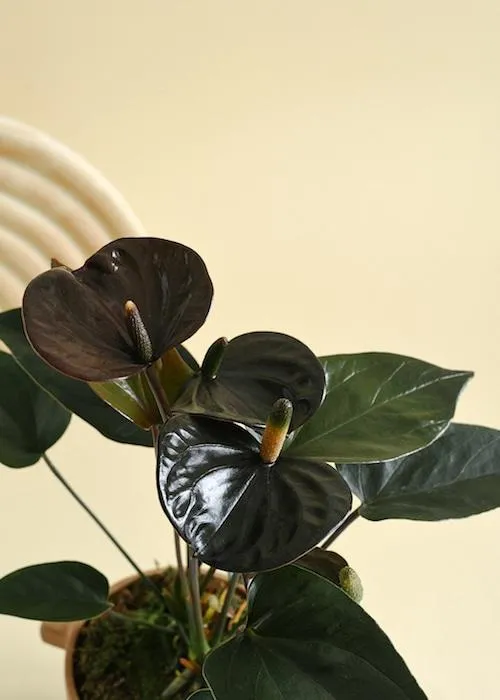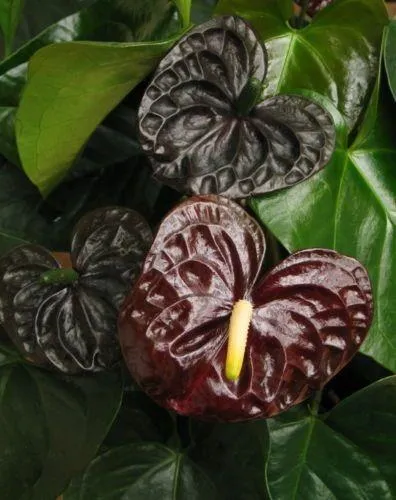Everything You Need to Know About the Anthurium Black Velvet Plant
The anthurium black velvet is a stunning variety of flowering houseplant known for its uniquely dark, velvety leaves. If you’ve become enamored with this plant after seeing pictures online or at a local nursery, you’ve come to the right place. In this in-depth guide, I’ll cover all the essential details on caring for, growing, and enjoying this beautiful tropical variety.
What Makes the Anthurium Black Velvet Special?
- Dark, Plush Leaves: As the name implies, the leaves of this anthurium are nearly black in color with a rich, velvety texture. This gives the plant an alluringgothic appearance.
- Heart-Shaped Spathes: Like other anthurium varieties, the black velvet produces showy white or pink heart-shaped spathes (modified leaves that protect the flowers).
- Low Light Tolerance: Despite its striking foliage, this plant thrives in low to medium light conditions making it suitable for indoor growing.
From my experience caring for black velvet anthuriums, their unique leaf color and texture makes them real showstoppers in any space. The dark leaves serve as a striking contrast to their white blossoms.
Top Tips for Growing Anthurium Black Velvet
Light: As mentioned, the black velvet anthurium prefers low to medium, indirect sunlight. East or west-facing windows provide the perfect conditions. Avoid direct sun which can scorch the leaves.
Temperature: Keep soil temperatures between 65-80°F for optimal growth. Try to avoid letting it drop below 60°F.
Water: Water when the top inch of soil is dry. Let excess water drain from the saucer. Under-watering is better than over-watering which causes root rot.
Humidity: Mist leaves frequently and make sure humidity levels stay between 50-70%. A pebble tray underneath boosts humidity.
Fertilizer: Feed monthly in the spring and summer with a balanced houseplant fertilizer diluted to 1⁄2 the recommended strength.

Here’s a trick I’ve used – tying a moist paper towel around the stems keeps humidity levels high for new growth. Black velvets love the extra moisture. With the right care, you’ll have this showstopper thriving for years.
Tips for Displaying Anthurium Black Velvet
Now that you’re growing a beautiful black velvet anthurium, here are some creative ways to feature it:
- Place on a table near a window to highlight the striking leaves.
- Hang a trailing basket from above to draw attention upwards.
- Include in an arrangement with brightly colored tropical plants for high contrast.
- Gift a black velvet in a decorative pot as a unique housewarming present.
- Decorate with string lights draped overhead after dark for a moody vibe.
I honestly think these plants make awesome table centerpieces. From my experience, guests are always drawn to them and want to feel the plush leaves! Their slightly creepy yet alluring vibe creates conversation.
Common Pests and Problems
While generally low-maintenance, black velvet anthuriums aren’t entirely problem-free. Here are some issues to watch out for:
Spider Mites: These tiny pests can cause leaf stippling and webbing. Rub leaves with a cotton ball dipped in neem oil as a natural treatment.
Mealybugs: Fluffy white insects cluster at leaf joints. Wipe with isopropyl alcohol on a q-tip to remove. Repeat as needed.
Root Rot: From soggy soil. Improve drainage and airflow. Carefully remove affected roots and repot in fresh soil.

The key is prevention by keeping humidity high and the soil mostly dry. Regular inspections allow early issues to be nipped in the bud. Proper care results in healthy, thriving black beauties!
Frequently Asked Questions
Q: Can I propagate black velvet anthuriums?
Yes, both through stem cuttings and seed. For cuttings, remove 4-6” sections, allow to callus, and root in water or soil. Seeds require warmth and humidity to germinate.
Q: How long will my black velvet flower?
Flowers may last 2-3 months but may re-bloom periodically with optimal care. Remove spent flower spikes at the base to encourage re-blooming.
Q: Can I grow these outdoors in the summer?
Maybe in zones 9-11 if acclimated slowly. Elsewhere, black velvets are best kept indoors as a houseplant or moved to a porch on warm, shady days.

I hope this covers everything you need to know to grow and enjoy your very own anthurium black velvet houseplant! Let me know if any other questions come up. Happy growing!
Anthurium Black Velvet Care Tips
| Light Needs | Bright, indirect light. Keep out of direct sun which can scorch leaves. |
|---|---|
| Water | Let soil dry slightly between waterings. Water thoroughly when dry and don’t let sit in water. |
| Humidity | Keep humidity between 50-60%. Mist leaves daily and group with other plants. |
| Temperature | Ideal temperature range is 65-75°F. Avoid drafty spots and wide temperature fluctuations. |
| Fertilizer | Feed monthly in spring and summer with a balanced houseplant fertilizer diluted to half the strength. |
| Propagation | Propagate from stem or leaf cuttings in spring or summer in water or potting mix until roots form. |
FAQ
-
What kind of plant is anthurium black velvet?
Anthurium black velvet is a type of flowering plant from the family Araceae. Basically, it’s a tropical plant native to tropical regions of Central and South America.
-
What does an anthurium black velvet plant look like?
An anthurium black velvet has heart shaped leaves that are dark burgundy or almost black in color. The flowers have a waxy texture and appear in clusters. They are usually a deep red color, almost looking black. The unusual dark coloring makes this plant kind of striking.
-
How do you care for an anthurium black velvet?
To care for an anthurium black velvet, keep it in a warm environment around 70-80 degrees Fahrenheit. Provide moist but well-draining soil and water whenever the top inch becomes dry. Also, make sure it gets indirect sunlight each day. With the right care, it may produce flowers for months on end!
-
Does an anthurium black velvet need fertilizer?
Yes, fertilizing your anthurium black velvet during its growing season will help keep it healthy and encourage flowering. You can use a general houseplant fertilizer every few weeks during spring and summer. Just be careful not to overdo it – too much fertilizer might damage the roots. Less is more with these finicky plants.
-
How do you propagate an anthurium black velvet?
There are a few different ways to propagate this plant. You can divide the root ball or take stem cuttings and place them in water to grow new roots. However, growing plants from seed might be the most challenging route. Perhaps the easiest method is division, since the plant’s thick roots can be separated into several new individual plants.
-
What are anthurium black velvet plants used for?
While anthurium black velvet plants make lovely houseplants noted for their unique black foliage, some people also use them commercially. Floral shops and plant nurseries sell the flowers for indoor decor. At the same time, their dark waxy blooms are occasionally used in floral arrangements. On the other hand, many gardeners just enjoy these plants as a conversation piece!

-
Are anthurium black velvet plants toxic to pets?
Yes, most varieties of anthurium are mildly toxic if consumed by pets. While dogs and cats may be drawn to the attractive flowers and glossy leaves, chewing or eating any part of the anthurium black velvet can potentially cause irritation or vomiting in some animals. It’s best to keep these plants out of reach if you have curious pets around. Your furry friends will thank you!
-
In summary, what are the most important tips for caring for an anthurium black velvet?
To review the top things to know: Provide moderate watering and humidity; fertilize spring-fall; keep soil moist but well-draining; place in bright, indirect light; divide or take stem cuttings to propagate; and remove from pet access, due to mild toxicity. With the right conditions, this stunning plant can last for years giving you stunning dark foliage and flowers to enjoy. Simply follow these basic tips for success!
